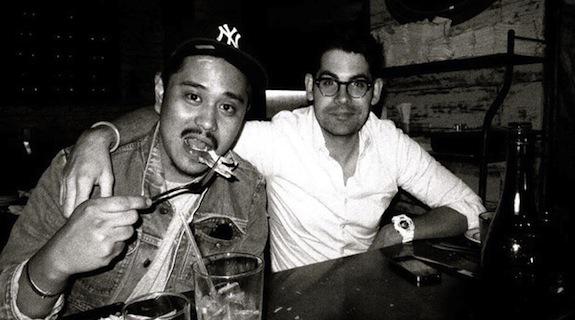[Above: Mark Portillo and Jimmy Repeat of the artist collective, Mr. GIF.]
The GIF (Graphics Interchange Format) has come a long way since CompuServe launched the technology in 1987 as a means to better transfer color image files. Long a staple of banner ads and other online promo content, the rise of Tumblr and the innovative/incessant efforts of outlets such as BuzzFeed have ushered GIFs into editorial spaces as well, where the format’s rapid-fire, flip-book-style storytelling capability can provide an efficient visual supplement to text—or sometimes replace text entirely.
And of course the TV industry has caught on to GIFs’ singular ability to quickly convey something entertaining and sharable. Though, to hear Jimmy Repeat of the artist collective Mr. GIF tell it, major media players don’t always maximize the format’s potential.
“Sometimes big companies think they can do GIFs themselves, but they don’t really understand the benefits that Tumblr offers” said Repeat who, along with his Mr. GIF creative partner Mark Portillo, saw their creations attain widespread popularity on the Yahoo!-owned microblogging platform. “They’ll be like, ‘we can just screen-capture this 15-second ad and put it up on Tumblr and that’ll be fine,’ when the beauty of working on Tumblr with animated GIFs is collaborating with artists and using their followers too. [Those artists’] followers are already interested in their work, so why not create [GIFs] and also tap into thousands of people at the same time?”
Repeat and Portillo became friends while studying graphic design at the Fashion Institute of Technology in New York. They started creating GIFs as a hobby “back when GeoCities was still a thing” said Repeat. Their work got increasingly sophisticated and, thanks to Tumblr, increasingly visible on the Internet, eventually catching the attention of Marc Ecko. The fashion entrepreneur offered the duo their first GIF-related paid gig, which involved turning dozens of his speeches into a GIF-only PowerPoint presentation. From there, the dominos began to fall, and many more clients came calling, including “Forbes,” “VICE” magazine and “Late Night With Jimmy Fallon.”
Mr. GIF’s most recent commission came from IFC, who hired them to release a Tumblr series of promotional GIFs in advance of the weekly airings of Season 4 of “Portlandia.” Drawing on the cumulative power of the prolific GIF-making community, the duo assigned each episode to a different artist. Other than staying consistent with the show’s color scheme of black, white and a touch of orange, the artists were given one directive: create a GIF based on whatever scene spoke to them from the upcoming episode, in whatever style they wished.
“We wanted the artists to express their creativity,” said Repeat. “It was all about getting a different artist’s take on different episodes… What spoke to one artist as the funniest moment [from an episode] might not speak to another artist. Variety was key. We never wanted to tell them what to animate because you’d lose some of that magic.”
The results speak for themselves. One GIF, designed by acclaimed animators the Rauch Brothers, brings to life a line from a sketch in which Carrie Brownstein and Fred Armisen play a pair of hostile trees: “I will not die to be a Post-It!”

Another, created by “MAD Magazine” illustrator Phil McAndrew, emerged prior to the April 10 episode, which featured a sketch with Portland’s NBA team, the Trailblazers, and the infamous feminist bookstore owners.

“There’s a lot of things you can do with a GIF,” said Repeat. “You can make it charged with emotion… It’s better than long-form. If you have to wait 16 seconds to see an ad, that’s 16 seconds you really didn’t have. A GIF gives you the idea in a second or three seconds. It’s lighter and does more work.”
Tags:













































__twocolumncontent.jpg)











